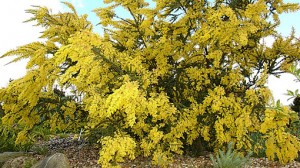 The weather? Wasn’t going to mention it but the hot sunshine after a monsoon winter and cold spring was welcome. Many of the shrubs and trees really have benefitted from the wet and have enjoyed the sunshine. My acacia pravissima, the beech hedge, and the camellias – all are looking well. Everybody’s hydrangeas look good too. I planted a relatively new variety earlier this year and I cannot wait for Pinky Winky to flower!
The weather? Wasn’t going to mention it but the hot sunshine after a monsoon winter and cold spring was welcome. Many of the shrubs and trees really have benefitted from the wet and have enjoyed the sunshine. My acacia pravissima, the beech hedge, and the camellias – all are looking well. Everybody’s hydrangeas look good too. I planted a relatively new variety earlier this year and I cannot wait for Pinky Winky to flower!
So in this month of August when you thought you would be sitting in a deck chair I suspect you have mountains of weeding to do. It’s easiest to get out the hoe but I recommend where possible doing it by hand. Take a really close look in the borders and you will see fledgling plants by the thousands. Many flowering plants will seed in the borders. My brilliant orange Escholtzia are widely admired and every single one has come from one packet of seed that I sowed 5 years ago. They look fantastic amongst the blues and purples of the lavenders. But the biggest clump is of course right in the middle of the runner beans, bit too glorious to move now.
 As I weed I find them emerging and I lift them carefully and immediately replant where I want them to flower. They will grow and seed this year and be there again next year too together withal the family they have raised! This process applies to many that seed freely. Echium pininana must be lifted whilst very small or they will not transplant but look out too for the seedlings of aquilegia, oriental poppies, foxgloves, hellebores and centranthus. I always look at these little chaps and think if I had bought that plant several months on it would probably have cost me £6. Just look at all the six quids growing in your garden and it puts the whole process in a rather different light!
As I weed I find them emerging and I lift them carefully and immediately replant where I want them to flower. They will grow and seed this year and be there again next year too together withal the family they have raised! This process applies to many that seed freely. Echium pininana must be lifted whilst very small or they will not transplant but look out too for the seedlings of aquilegia, oriental poppies, foxgloves, hellebores and centranthus. I always look at these little chaps and think if I had bought that plant several months on it would probably have cost me £6. Just look at all the six quids growing in your garden and it puts the whole process in a rather different light!
You have to bear in mind of course that in the time it has taken for the mother plant to grow and set seed our friends the bees and other pollinators have also been at work and may well have altered the course of nature. I have a plethora of pink oriental poppies never having planted one. These are the self-set seedlings that are a hybrid version of a brilliant red poppy and a white one. Some plants are much more promiscuous than others therefore the poppies aquilegia and hellebores will turn up in a variety of colours and the foxgloves will usually return to the original grandparental purple, the strongest colour for the plant.
 It is time now to think about next spring too. Start ordering any spring bulbs you may require for planting over the next few months. You can also find saffron crocus bulbs to plant this month and may get flowers in October. I planted my saffron crocus August 2011 and had a few flowers in the October from which I painstakingly tweezered out the red stamens. I dried them in the airing cupboard and had enough to cover the bottom of a jam jar. Last year we had a really healthy crop and I have lifted huge bulbs and shred them with saffron bun makers! It’s a hugely laborious process for very little produce but when you consider that saffron is as more expensive than gold it’s well worth doing.
It is time now to think about next spring too. Start ordering any spring bulbs you may require for planting over the next few months. You can also find saffron crocus bulbs to plant this month and may get flowers in October. I planted my saffron crocus August 2011 and had a few flowers in the October from which I painstakingly tweezered out the red stamens. I dried them in the airing cupboard and had enough to cover the bottom of a jam jar. Last year we had a really healthy crop and I have lifted huge bulbs and shred them with saffron bun makers! It’s a hugely laborious process for very little produce but when you consider that saffron is as more expensive than gold it’s well worth doing.
This October I shall have a full flush of flowers and may get an inch up the jar! However I will have the best batch of yellow buns you have ever seen and there is something very satisfying about growing the crocus, seeing the leaves, harvesting the bright red stamen six months later and then cooking the saffron bun! Yes, I heard you the first time – ‘get a life!’
 I was fortunate to have a second visit to Highgrove recently. If you ever get the opportunity I recommend it highly. HRH is very keen to share his garden and welcomes groups that share his interest in gardens. I have to say that after my last tour five or six years ago I may not have recommended a visit. There were some very quirky almost childish areas but all that has gone and the garden is now a sheer delight (bar one small area that I think he has ruined!).
I was fortunate to have a second visit to Highgrove recently. If you ever get the opportunity I recommend it highly. HRH is very keen to share his garden and welcomes groups that share his interest in gardens. I have to say that after my last tour five or six years ago I may not have recommended a visit. There were some very quirky almost childish areas but all that has gone and the garden is now a sheer delight (bar one small area that I think he has ruined!).
His organic principles are immoveable and to be admired. I am as organic as I can be but have to resort to the chemical occasionally. He never does and wow does it show. It has taken at least 25 years to get to the point he is at but when you see hundreds of hostas many in deep shade under trees in the dampest areas and without a slug whole in sight then you know it works. Where he has perennial weed he spends years just growing annuals so that he can weed out the area by hand (probably not always his hand!) and wear down the spirit of that weed to grow. Labour intensive, sometimes taking years, but the results are truly amazing.
When you have recovered from weeding, mowing and picking try and find time to go round labelling things that you need to move or attend to in the autumn. Whilst herbaceous plants are in full leaf it is much easier to determine which clumps need splitting, which need moving and also identifying gaps that appear so miraculously. Gaps in an herbaceous border are just areas for weeds to set seed.
 Finally I have to tell you about a new ‘pest ’in my garden. One of a brood of blackbirds from this season’s hatch is my new best friend. He is not concerned about my presence and is never far away from where I am working. He is a sheer delight hopping about and singing at the top of his voice. We have however had to have words recently. He started stripping the strawberries in the garden, (I have netted for the first time ever) he went on to strip the blueberries in the polytunnel and now he accompanies me at 7.30am and 5pm on the dot to pinch pig nuts at feeding time! I have also had to put net over the polytunnel entrance as he is up with the lark to precariously balance on the tomato plants and he is munching his way through them too! And I thought slugs and snails were a problem…Bless him!
Finally I have to tell you about a new ‘pest ’in my garden. One of a brood of blackbirds from this season’s hatch is my new best friend. He is not concerned about my presence and is never far away from where I am working. He is a sheer delight hopping about and singing at the top of his voice. We have however had to have words recently. He started stripping the strawberries in the garden, (I have netted for the first time ever) he went on to strip the blueberries in the polytunnel and now he accompanies me at 7.30am and 5pm on the dot to pinch pig nuts at feeding time! I have also had to put net over the polytunnel entrance as he is up with the lark to precariously balance on the tomato plants and he is munching his way through them too! And I thought slugs and snails were a problem…Bless him!

